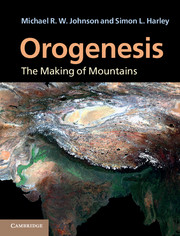Book contents
- Frontmatter
- Contents
- Preface
- Acknowledgments
- Geological timescale
- 1 Major features of the Earth and plate tectonics
- 2 Driving mechanisms for plates, slab retreat and advance, and a cause of orogenesis
- 3 Physical and chemical principles: rock deformation, isostasy, geochronology and heat production in the lithosphere
- 4 Large-scale features of orogens: thrusts and folds
- 5 Evolution of orogens
- 6 Lateral spreading of orogens: foreland propagation, channel flow and weak zones in the crust
- 7 Metamorphism in orogeny
- 8 The erosion and exhumation of mountains
- 9 Sedimentary history of the foredeep basins
- 10 Deep structure, mountain support and phase changes
- 11 Mountains and climate
- 12 Secular change in orogeny
- References
- Index
- Plate section
- References
8 - The erosion and exhumation of mountains
Published online by Cambridge University Press: 05 June 2012
- Frontmatter
- Contents
- Preface
- Acknowledgments
- Geological timescale
- 1 Major features of the Earth and plate tectonics
- 2 Driving mechanisms for plates, slab retreat and advance, and a cause of orogenesis
- 3 Physical and chemical principles: rock deformation, isostasy, geochronology and heat production in the lithosphere
- 4 Large-scale features of orogens: thrusts and folds
- 5 Evolution of orogens
- 6 Lateral spreading of orogens: foreland propagation, channel flow and weak zones in the crust
- 7 Metamorphism in orogeny
- 8 The erosion and exhumation of mountains
- 9 Sedimentary history of the foredeep basins
- 10 Deep structure, mountain support and phase changes
- 11 Mountains and climate
- 12 Secular change in orogeny
- References
- Index
- Plate section
- References
Summary
This is a large topic which covers the decay of mountain belts by erosion and more controversially, the possible link explored in Chapter 11 between mountain relief and climate. The topic has already been mentioned in Chapter 5 because it seemed appropriate to discuss the exhumation of the European Alps in the context of the recent dating of the HP metamorphism. A huge amount of literature now exists on the topic, which may be simply set out as the link that mountain building creates topography and this in turn generates precipitation as rain or snow and ice. A more accurate formulation would be that many factors are involved if the effect of topography on climate is to be more than transient. Thus mountains may amplify and modify rather than create precipitation in the first place. The relationship is well shown in the Canary Islands which are in a semi-arid belt. Low islands such as Lanzarote and Fuerteventura are semi-arid. However, on Tenerife there is a volcano of 3700 m altitude, rising straight from sea level. On the windward north side of the volcano the island is very wet, with green pastures on the coastal plain, whereas the leeward side is arid or semi-arid. As a consequence of the precipitation and thus enhanced erosion on the windward side of the island there is also a marked asymmetry in steepness of relief: the wet north side has steep relief and a distinct coastline with high cliffs whereas the leeward south side is more gently sloping. Some global climate models show that mountains, while they do not determine whether or not a monsoon occurs, tend to lengthen and enhance monsoonal periods.
The factors involved in climate include atmospheric circulation and ocean water circulation. If these are not appropriate then the mountains will not create precipitation. The English Lake District and the Scottish Highlands would not be such wet places if the global atmospheric circulation pattern in the form of the Atlantic ‘westerlies’ did not dominate the climate of Britain. Over the past 100 Ma temperatures have decreased globally and this has been attributed to changes in sea-floor spreading rates, or in land–sea distribution, or in the rates of out-gassing of volcanoes.
- Type
- Chapter
- Information
- OrogenesisThe Making of Mountains, pp. 259 - 273Publisher: Cambridge University PressPrint publication year: 2012

